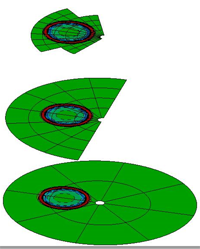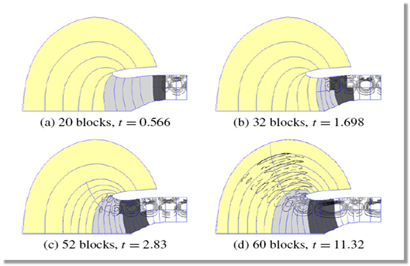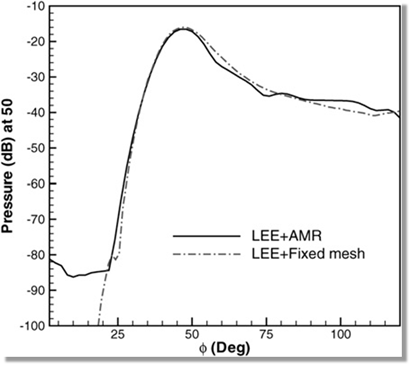A new computational tool was developed to efficiently predict sound radiation with block-structured adaptive mesh refinement (AMR) algorithm. The basic idea was to use grids of fine resolution only for the area where sound propagates. As a result the required grid number is reduced and the computational efficiency can be increased. The work includes parallel implementation of the AMR algorithm, a high-order solver, and linear models for acoustics. Practical problems, such as spinning modal radiation from an aero engine duct, were studied with the tool. Compared to the computation performed on a fixed mesh, the computational efficiency by the AMR method is increased extensively while the accuracy of the solution is still maintained.

Figure 1: Acoustic scattering computation by AMR.
The AMR algorithm is efficient and effective in treating problems with multiple spatial and temporal scales 1. It represents computational domain as hierarchal refinement levels and increases computational resolution only in areas of interest. A given spatial error tolerance is achieved by recursively refining meshes. Subsequently a localised mesh of high grid resolution is distributed within an otherwise coarse mesh. For example, Figure 1 shows the hierarchy grids for the computation of acoustic scattering from a cylinder 2. The computational efficiency is therefore improved by reducing the required number of computational cells.
Complex algorithms were implemented to refine/coarsen grids adaptively, manage data consistency over grids of different refinement levels, and partition workload evenly on parallel machines. Special treatment was conducted on the numerical solver to maintain high order of resolution on an adaptively refined mesh. The developed tool was applied to practical applications, such as the study of spinning modal radiation from aero engine intake and bypass duct. Figure 2 shows one case, where the sound propagation out of the engine intake was computed on an adaptively refined mesh. The workload was redistributed in every several time steps over parallel processors, which are denoted by different colours. Figure 3 compares the far-field directivity results computed on a fixed fine mesh and the adaptively refined mesh. Both results agree well at almost all radiation angles. In addition, the computation speed by the AMR method is increased by 50%.

Figure 2: The computation of sound propagation out of an engine intake on an adaptively refined mesh.

Figure 3: Farfield directivities for the engine intake case.
An efficient computational tool was developed based on the AMR algorithm. The accuracy and performance of the tool have been demonstrated successfully in practical aero engine problems. The power of the method should appear to other acoustic simulation problems with extensively heavy computational burden.